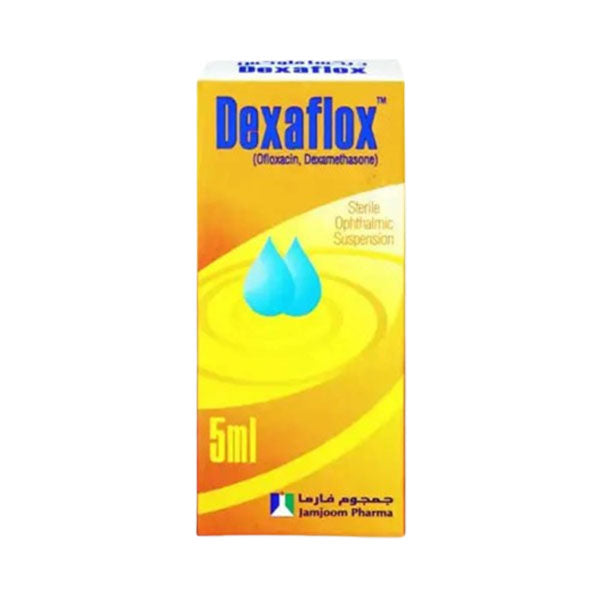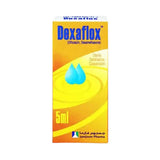Dexaflox eye drops 5 ml:
Ofloxacin/dexamethasone 3 mg/1 mg per 1 ml Eye drops 5 ml
What are the uses of ofloxacin/dexamethasone eye drops:
Ofloxacin/dexamethasone eye drops contain two active ingredients:
Ofloxacin is a quinolone antibiotic
Dexamethasone is a corticosteroid with anti-inflammatory properties
Ofloxacin/dexamethasone eye drops are used for corticosteroid-responsive inflammatory conditions of the anterior segment (conjunctiva, cornea, eyelid) and posterior segment inflammation where there is bacterial infection or risk of bacterial infection.
How to use ofloxacin/dexamethasone eye drops:
- wash your hands. Tilt your head back and look at the ceiling.
- Gently pull the lower eyelid down until there is a small pocket
- Turn the bottle upside down and squeeze to release 1 or 2 drops into each eye that needs treatment.
- Let go of the lower eyelid, and close your eye for 30 seconds. If you lose your eye drops, try again.
- To avoid contamination, do not let the dropper tip touch your eye or anything else. Replace and tighten the cap immediately after use.
Do not use ofloxacin/dexamethasone eye drops if:
If you are allergic to any of the ingredients of this medicine.
Warnings and precautions:
Tell your doctor about all your health conditions, including, if you:
- Sensitive to other quinolone antibacterial agents. Long-term use may result in new bacterial infections that do not respond to ofloxacin.
- The presence of a defect or ulceration on the surface of the eye.
- Diabetics
- Hypertension
- Are born with or have a family history of a prolonged QT interval, have a blood salt imbalance, have a very slow heartbeat, have a history of heart attacks, are female or elderly or take other medications that cause abnormal changes. Normal electrocardiogram.
Possible side effects:
The following side effects are also known to occur, including:
- Allergic reactions.
- Hormonal problems.
- Eye irritation.
- Eye discomfort.
- Visual disturbances.
- tearing down.
- inflammation.
- redness.
- Sensitivity to light.
- Feeling that there is something in your eyes.
- Eye swelling.
- Swelling around the eyes.
- Eye pain.
- Drought.
- Dizziness.
- Nausea.
- Life-threatening arrhythmia.
- Glaucoma.
- Cataracts.
the components:


